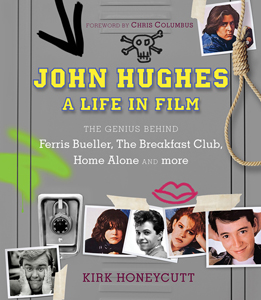Coffee-table books are a risky proposition, as they can lure you in with nice design and colorful photos only for you to later discover that the prose was the least concern of the publishers. Luckily, “John Hughes: A Life in Film” (2015), by film critic and reporter Kirk Honeycutt, puts the writing first, and also features decent design.
Since there’s (surprisingly) a dearth of Hughes biographies out there, Hughes superfans will want to have this in their collection, with the caveat that deeper scholarship might be published in the future.
Intelligent but sensitive
Drawing from enough of Hughes’ colleagues to paint a picture, Honeycutt portrays Hughes (1950-2009) as an intelligent writer whose overly sensitive nature drove off friends and collaborators, who was most comfortable in Chicago but who was happy to cash huge Hollywood checks, and who faded from the scene because he was creatively burned out and was always a family man – not because he was a J.D. Salinger-level recluse.
Likewise with the art, there’s enough here to make “A Life in Film” pleasant to look at – posters, stills of actors, set photos – but I hope there’s more out there for future publications.
In both information and visual archives, we’re perhaps at the mercy of Hughes’ relatives for how much insight we’ll get in the years ahead.
Hit-and-miss coverage
As the author goes through Hughes’ life and films chronologically, “A Life in Film” gives good coverage of the core works – “Vacation,” the 1980s teen classics, the John Candy collaborations and “Home Alone” — plus the wildly ambitious, commercially and critically dismissed “Baby’s Day Out.”
For the big-name films, Honeycutt segues into reviews; this breaks from the biographical approach, but I like it because he’s a good critic. It’s interesting to see what films he praises, what films he loathes, and what films he’s indifferent to. He breaks from convention at times, but backs it up.
I think it’s wild that he dislikes “The Great Outdoors” and “Christmas Vacation,” but I can’t say Honeycutt doesn’t make his case. I would’ve liked an appendix where the author ranks Hughes’ catalog.
If you’re interested in a deep dive into Hughes’ lesser entries, you won’t get it here; Honeycutt very much treats films like “Career Opportunities” and “Dutch” as lesser, tossing off a few paragraphs to explain their flaws. Ideally, I would’ve liked more information on the lesser films’ production to get a feel for why they turned out to be weak.
For example, he’s right that “Career Opportunities’ ” final act is a misfire, but I’d like to know the behind-the-scenes hows and whys. Failures can be as fascinating as successes.
The 1983 historical swashbuckler “Nate and Hayes” is not mentioned at all – even in the filmography — making me wonder if there’s a bizarre, widespread mistake about it being co-written by Hughes. I think “N&H” is worth exploring, as it’s a rare case of Hughes going outside his teen and family comfort zones and doing a genre piece.

Some juicy nuggets
Honeycutt’s juiciest bombshell is that “Dumb and Dumber” – one of my all-time top 10 movies — originated from a Hughes story, enough so that Hughes would’ve gotten a story credit except that he sold the story on the condition that he not be credited.
Another tantalizingly skimmed-over element is the revelation – via a Matthew Broderick quote — that many unproduced Hughes screenplays exist.
But no posthumous Hughes films have come out (other than continuations of franchises such as “Vacation” and “Home Alone”) – and indeed, his last produced screenplay was eight years before his death — so I’d like to know why this is.
Despite its holes, “John Hughes: A Life in Film” is a good place to start if you want to learn the basic biographical details and personality of the man who changed teen-centered filmmaking and later became a family-film icon. But someone – maybe Honeycutt himself – should dig deeper for a future work.


